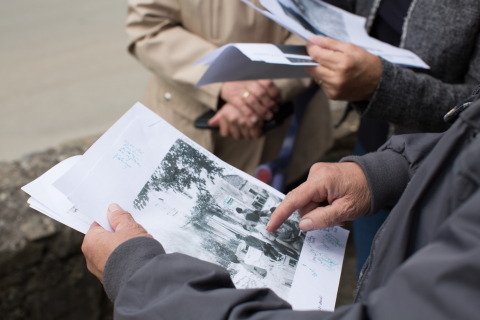
Recent years have seen an increased popularity of collaborative work and ‘crowd’ involvement in academic research and cultural heritage institutions, where researchers, curators, and librarians aim to involve the public in order to achieve better engagement with collections or to produce new scholarship.
It is in the context of our effort to transcribe and translate the audio material recorded by Tony Hurren in the 1960s that crowdsourcing has emerged as a crucial element of our project. If native speakers are the most precious and authoritative asset for the study of a language, and especially a disappearing one, why not try to involve the remaining speakers of vlåški and of žejånski to help us understand the most problematic segments of the audio material left by Hurren?
The term ‘crowdsourcing’ suggests large numbers of contributors, while the number of Istro-Romanian speakers is rather small. This brings our project closer to newer models of engagement adapted to the specific communities targeted. These projects resort to a different terminology, such as ‘micro-volunteering’, ‘community sourcing’, or ‘targeted crowdsourcing’ (Owens 2014), to acknowledge the fact that the ‘crowds’ are less large and not necessarily anonymous. Scholarship on crowdsourcing suggests that people become invested in, and tend to support, projects which tap into their identities and provide them with a sense of purpose (Eccles and Greg 2014). Our preliminary research has suggested that, despite their small number, speakers of Istro-Romanian are active online and through social media, and are deeply invested in the preservation of their linguistic and cultural identity.
While conventional crowdsourcing projects aim to attract as wide a ‘crowd’ as possible and, from that, carve out a smaller ‘community’ of invested participants, we start from an existing, albeit limited, number of already invested speakers of Istro-Romanian whom we will invite as peer contributors to our project in order to help us interpret the most problematic segments of our audio material.
We hope that ISTROX will allow these speakers to do more than circulate existing knowledge about their language: to become also co-creators of a new body of linguistic knowledge which will later be incorporated into the wider process of transcription and translation of the Hurren material, and examined in our subsequent linguistic analysis.
We are keen to stress that the idea of ‘co-production’ is at the heart of our project, where research will be conducted collaboratively with the Istro-Romanian community rather than being simply about it, or about their language. In the spring of 2019, we visited the communities of speakers of žejånski and vlåški in Žejane and Šušnjevica, and met some of the original participants in Tony Hurrens' research and the relatives of others, who showed interest in our project. Yet in a world which relies increasingly on online interactions, we hope that the community-sourcing element of our research will activate not only the Istro-Romanian communities of Croatia but also those from the diaspora, thus sparking renewed international interest in the language and its speakers.
Our main goal is to preserve a record of this disappearing language, both for the community of speakers and their descendants, and for linguistic scholarship. Upon completion (August 2020), the ISTROX project will make all the (ethically cleared) original material and resulting research data available online for the benefit of the scholarly and the Istro-Romanian communities.
We are very grateful to Dr Robert Doričić and Mrs Viviana Brkarić for their generous assistance in putting us in touch with members of the Istro-Romanian community. We also thank the members of the community in Žejane and Šušnjevica for receiving us so kindly and for giving so freely of their time to help us.
References
- Eccles, C. and Andrew Greg, A. (2014). Your Paintings Tagger: Crowdsourcing Descriptive Metadata for a National Virtual Collection. In Ridge, M. (ed) Crowdsourcing our Cultural Heritage, Routledge, 185-208
- Owens, T. (2014). Making Crowdsourcing Compatible with the Missions and Values of Cultural Heritage Organisations. In Ridge, M. (ed) Crowdsourcing our Cultural Heritage, Routledge, 269-280